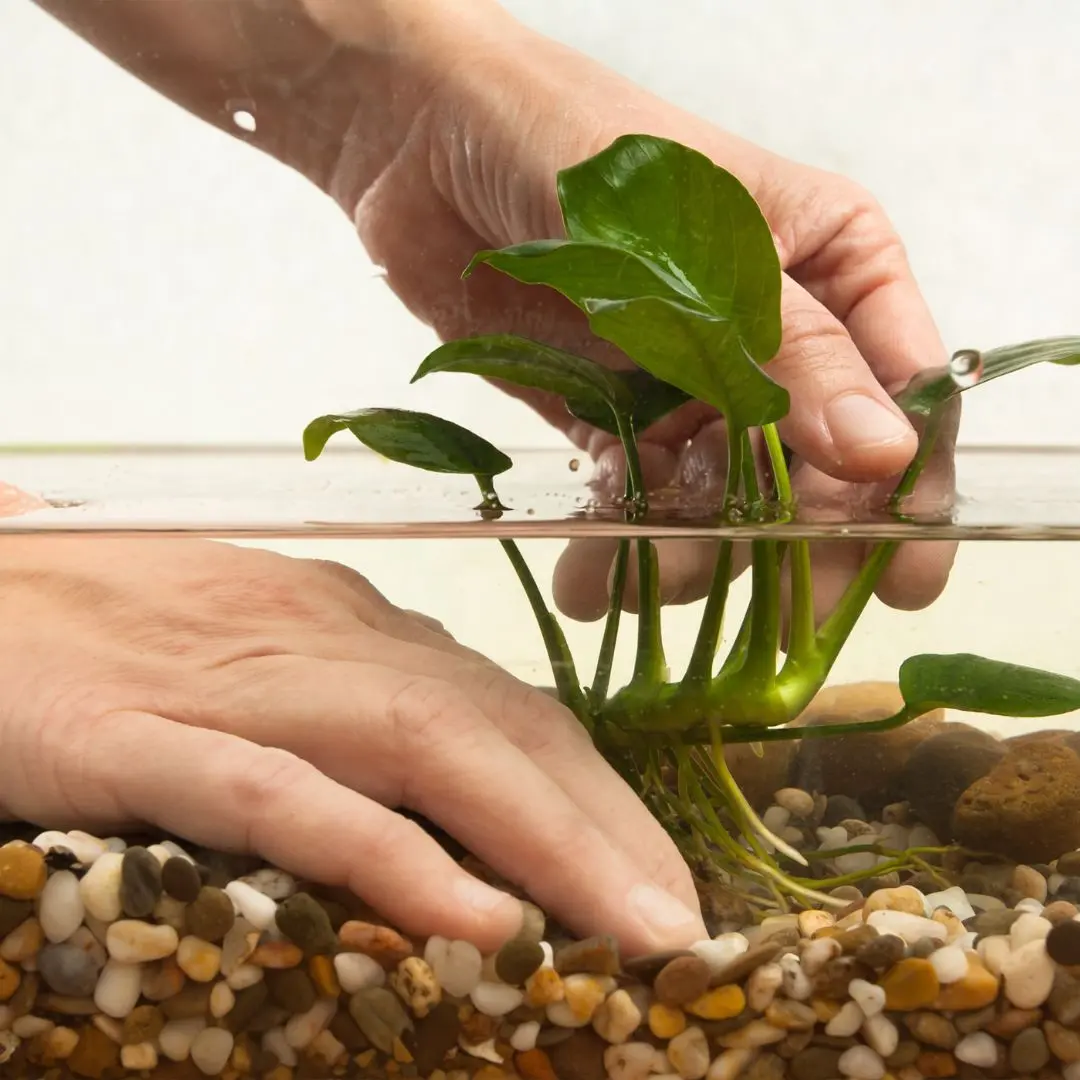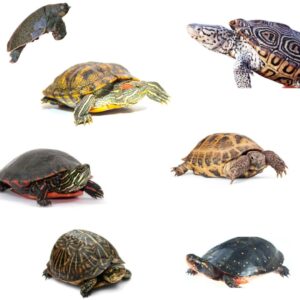Although they’re not necessary, aquatic plants can greatly impact your turtle’s well-being.
Plants for turtle tank:
- Act as a natural water-filtration system
- Provide cool, shady areas for turtles
- Serve as a healthy snack – an addition to your turtle’s regular diet
- Mimic a turtle’s natural habitat, encouraging foraging behavior, which is mandatory for their mental and physical stimulation
- Prevent algae spread by using valuable nutrients from their environment to grow
I’ve listed some of the best underwater and floating plants you should consider for your turtle tank.
Let’s check them out.
Best Plants for Turtle Tank
| Underwater Plants |
| Anubias Barteri |
| Java Fern |
| Java Moss |
| Hornwort |
| Moneywort |
| Anacharis |
| Amazon Sword plant |
| Floating Plants |
| Duckweed |
| Water Lettuce |
| Salvinia |
| Amazon Frogbit |
Table of Contents
Anubias Barteri
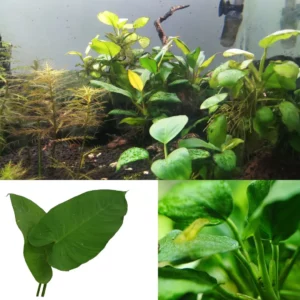
Anubias barteri, a well-liked aquatic plant species from the Araceae family, is native to West Africa. It thrives in calm streams, swamps, and other freshwater environments. Most turtle owners love this plant due to its appealing look and low maintenance requirements.
With its heart-shaped, dark green leaves arranged in a rosette formation, Anubias barteri grows from a sturdy, crawling rhizome. Although it can grow up to 12 inches tall in optimal conditions, it usually stays smaller when kept in aquariums.
Compared to most other aquatic plants, Anubias Barteri is a hardier, durable plant that can withstand more than just a casual nibbling session from your shelled companion(s).
It also doesn’t require special fertilizers or constant attention for potential entangles. Anubias thrives in most water conditions and grows slowly, so you won’t be trimming constantly.
But keep in mind that this plant is one of the slowest growing ones on the list, so you’d have to be super patient while your underwater jungle takes shape.
| Features | |
| Binomial Name | Anubias barteri var. barteri |
| Family Name | Araceae |
| Growth Rate | Slow |
| Hardiness/Durability | Extra hardy |
| RecommendedWater pH | 6.5 – 8.0 |
| Recommended Temperature | About 75°F/23.9°C |
| Recommended Lighting | Low to medium |
Java Fern
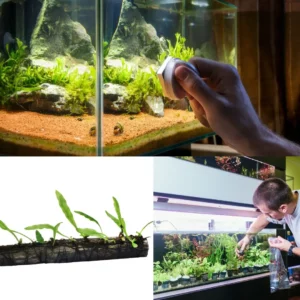
The Java Fern, also known as Microsorum pteropus, is a well-known aquatic plant admired for its beauty and low maintenance requirements. This plant belongs to the Polypodiaceae family and is native to Southeast Asia, where it thrives in rivers, streams, and marshes.
Unlike many other aquatic plants, the Java Fern does not need to be planted in the substrate. Instead, it can be easily attached to substrate like rocks, or other decorations using thread, fishing line, or adhesive.
The Java Fern can endure various water conditions. It can flourish in environments with both low and high light, although its growth may be slower in lower-light settings.
However, Java Ferns grow at a leisurely pace, so be patient while your underwater jungle takes shape.
Note: Unlike some plants that happily bury their roots in the substrate, Java Ferns prefer attaching to rocks or driftwood. This might not work for all tank setups.
| Features | |
| Binomial Name | Microsorum pteropus |
| Family Name | Polypodiaceae |
| Growth Rate | Slow to Moderate |
| Hardiness/Durability | Hardy |
| RecommendedWater pH | 6.0 – 7.5 |
| Recommended Temperature | 70~75°F/21.1~23.9°C |
| Recommended Lighting | Low to high |
Java Moss
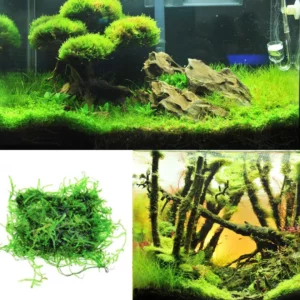
Java Moss is a relatively low-maintenance moss found in freshwater aquariums. It can either float freely or be attached to surfaces such as rocks or driftwood. As it grows, it forms mats that serve as hiding spots and areas for hatching.
This moss can adapt to various aquarium conditions but flourishes in environments with more light.
Unlike some delicate plants, Java moss is a tangled maze most turtles find unappetizing. This lets your little explorer navigate and climb without munching everything in sight! This makes it a good choice for turtles who don’t need plant food in their diet.
Once it grows enough, the dense moss provides shady hideaways and plenty of substrate-like surfaces for foraging activities like burrowing, digging, searching for food, etc.
But remember that Java moss grows like, well, moss! It can spread quickly and potentially clog filters or smother other plants. Regular trimming is key to keeping it under control.
| Features | |
| Binomial Name | Taxiphyllum barbieri |
| Family Name | Hypnaceae |
| Growth Rate | Fast |
| Hardiness/Durability | Extra hardy |
| RecommendedWater pH | 6.5 – 7.5 |
| Recommended Temperature | 70~75°F/21.1~23.9°C |
| Recommended Lighting | Low to high |
Hornwort
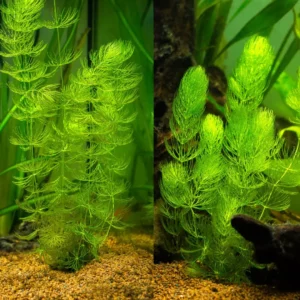
Commonly known as rigid hornwort, coon’s tail, or coontail, the Hornwort is another great example of an aquatic plant for turtle tanks.
It’s highly favored for turtle tanks due to its looks, affordability, and relatively low maintenance level. It also grows fast, so you don’t have to wait long for it.
However, it’s important to note that each branch or piece of the plant can grow quite large. If left to float freely, it may occupy excessive space and hinder your turtle’s movement in and out of the water.
Unlike some delicate plants, Hornwort’s soft, needle-like leaves are perfect for curious turtles to explore and munch on (though they’re not the main dish!).
The dense tangle of Hornwort creates a cool, sheltered area for your turtle to relax and feel secure, reducing stress – a great choice for turtles who thrive in a bit cooler environment.
Hornwort can take over a tank quickly if not managed. Regular trimmings are key to controlling and preventing it from blocking light or filters – be ready for extra trimming sessions!
| Features | |
| Binomial Name | Ceratophyllum demersum |
| Family Name | Ceratophyllaceae |
| Growth Rate | Fast |
| Hardiness/Durability | Extra hardy |
| RecommendedWater pH | 6.5 – 7.5 |
| Recommended Temperature | About 75°F/23.9°C |
| Recommended Lighting | Medium |
Moneywort
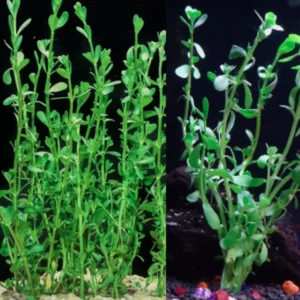
Moneywort is not as popular as some other plants, but its simple looks, relatively small size, and high adaptability make it a great choice for anyone.
This aquatic plant is also edible and non-toxic for turtles. It grows well even in simple setups, so it’s great if your turtle doesn’t like crowded spaces but still enjoys nibbling on some plants.
It grows quickly and requires moderate to high lighting to grow quickly. Moneywort doesn’t require CO2 supplementation to grow at a stable rate, and it’s not a messy plant, so it’s easy to take care of.
Unlike some finicky plants, moneywort’s tender leaves are a favorite munchie for many turtles. Consider it a healthy salad bar right in their tank!
Unique aesthetics: Its leaves have a different, more unique look compared to other aquatic plants, adding that extra touch to your turtle tank’s decor.
| Features | |
| Binomial Name | Lysimachia nummularia |
| Family Name | Primulaceae |
| Growth Rate | Fast |
| Hardiness/Durability | Hardy |
| RecommendedWater pH | 6.0 – 7.0 |
| Recommended Temperature | 75~80°F/23.9~26.7°C |
| Recommended Lighting | Medium |
Anacharis
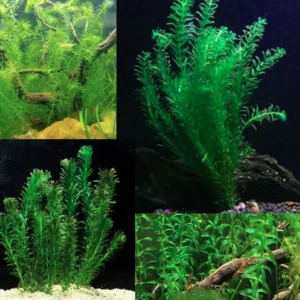
Anacharis, also known as waterweed, is a popular aquatic plant that is easy to care for and is one of the best turtle-safe plants – it’s favorite among omnivorous types of pet turtles like Red-eared sliders and Painted turtles.
However, primarily carnivorous turtles like Musk and Mud turtles usually do not bother consuming this plant.
Due to its fast-growing nature, you should never plant it outside as it grows fast and can become invasive.
| Features | |
| Binomial Name | Elodea spp. |
| Family Name | Hydrocharitaceae |
| Growth Rate | Moderate |
| Hardiness/Durability | Normal |
| RecommendedWater pH | 6.5 – 7.5 |
| Recommended Temperature | 70~80°F/21.1~26.7°C |
| Recommended Lighting | Medium |
Amazon Sword Plant
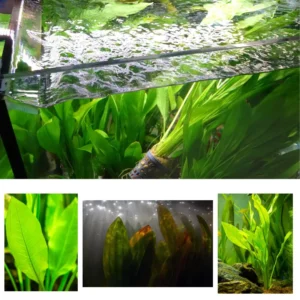
The Amazon Sword plant is a popular choice for decorating turtle tanks. It’s easy to care for but requires ample light, so it should be placed in a well-illuminated area.
Unlike other aquatic plants, the Amazon sword plant needs a substrate to thrive. While it doesn’t necessarily need to be placed into the sand, you can keep it anchored using rocks – typically aquarium gravel or river rocks as the substrate.
Pro tip: If the turtle ever uproots it, just replant it again.
| Features | |
| Binomial Name | Echinodorus spp. |
| Family Name | Alismataceae |
| Growth Rate | Moderate |
| Hardiness/Durability | Hardy |
| RecommendedWater pH | 6.5 – 7.5 |
| Recommended Temperature | 75~80°F/23.9~26.7°C |
| Recommended Lighting | Medium to high (preferably high) |
Duckweed
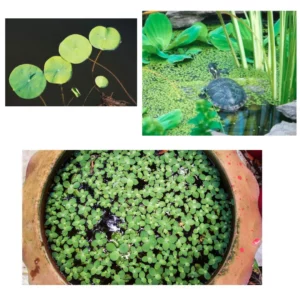
Duckweed works well for cutting out light into your aquarium because it becomes super tick and kinda ‘’pilled-up’’ as it grows – it can nearly cover the complete surface of water in the tank.
So, if you have other plants or turtles that like a dimmer lighting environment, duckweed is an amazing choice.
Removing small amounts of Duckweed regularly can also aid in removing excess nutrients from your aquarium setup, creating an additional biological filter.
One major drawback of having Duckweed is that it becomes extremely difficult to eradicate once it takes hold in your system. Even a lone plant can quickly multiply into numerous plants within days.
| Features | |
| Binomial Name | Lemna spp. |
| Family Name | Lemnaceae |
| Growth Rate | Extra fast |
| Hardiness/Durability | Hardy |
| RecommendedWater pH | 6.0 – 8.0 |
| Recommended Temperature | 70~75°F/21.1~23.9°C |
| Recommended Lighting | Low to High |
Water Lettuce
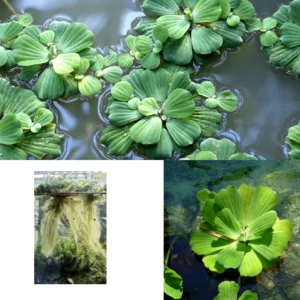
Water Lettuce is a highly sought-after aquatic plant for ponds, and it can even thrive indoors with sufficient lighting.
Apart from offering shelter to submerged turtles with their dangling roots, this plant efficiently absorbs a significant amount of ammonia and other nitrogenous wastes from the water. As a result, Water Lettuce serves as an effective means of controlling algae growth.
Shading the lower water column and absorbing nutrients that algae typically rely on helps maintain a balanced aquatic environment.
| Features | |
| Binomial Name | Pistia stratiotes |
| Family Name | Araceae |
| Growth Rate | Fast |
| Hardiness/Durability | Normal |
| RecommendedWater pH | 7.0 – 7.5 |
| Recommended Temperature | About 80°F/26.7°C |
| Recommended Lighting | Medium to high |
Salvinia
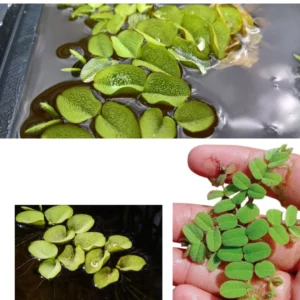
Salvinia, also known as Water Spangles, is a highly popular floating plant for turtle tanks and outdoor ponds due to its appealing appearance, adaptability, and quick growth rate.
It can thrive in a wide pH range and tolerate moderate to high lighting conditions. Its only specific requirement is that it does not fare well with constant surface agitation. So, keeping it in a place with gentle water flow is recommended.
By maintaining these simple conditions, Water Spangles will multiply quickly, contributing significantly to denitrification and oxygenation. Another advantage is that it does not need CO2 supplementation.
However, it’s important to occasionally remove some water spangle plants to prevent them from completely covering the water surface and suffocating the aquarium.
| Features | |
| Binomial Name | Salvinia spp. |
| Family Name | Salviniaceae |
| Growth Rate | Moderate |
| Hardiness/Durability | Hardy |
| RecommendedWater pH | 6.0 – 7.0 |
| Recommended Temperature | About 75°F/23.9°C |
| Recommended Lighting | Low to moderate |
Amazon Frogbit
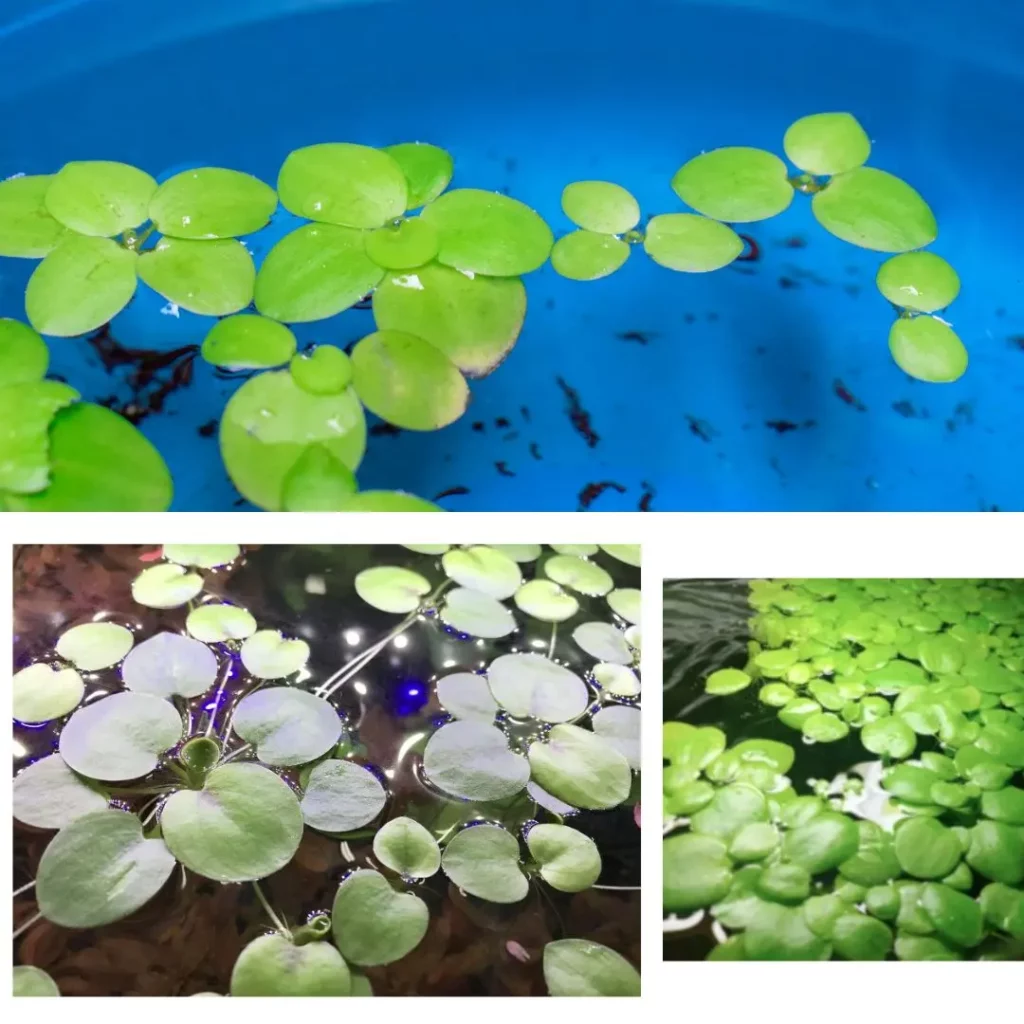
While most aquatic plants need to be compatible with substrates, Amazon Frogbit is a bit different – substrate shouldn’t pose any issues for this plant.
It floats on the water’s surface without being submerged. Its roots dangle within the water column while the leaves remain afloat. The Amazon frogbit obtains nutrients from the tank water through its roots, not the substrate.
You can use any substrate in the tank or select based on other preferences – whether you opt for gravel, sand, aquarium soil, or any other nutrient-rich substrate, the Amazon frogbit will thrive equally well.
| Features | |
| Binomial Name | Hydrocharis morsus-ranae |
| Family Name | Hydrocharitaceae |
| Growth Rate | Fast |
| Hardiness/Durability | Normal |
| RecommendedWater pH | 6.0 – 7.5 |
| Recommended Temperature | 70~75°F/21.1~23.9°C |
| Recommended Lighting | Low |
The Benefits of Keeping Plants In Your Turtle’s Tank
Using plants for a turtle tank is not just about decorating and making your turtle(s) habitat aesthetically pleasing – there are several other benefits as well!
Let’s check them out.
- Hide-and-seek haven: Imagine a lush underwater jungle for your turtle to explore and feel secure. Java Fern’s dense foliage provides shady hideouts, helping to reduce stress and encourage natural behaviors like foraging, playing, nibbling, etc.
- Hatching-friendly place: Certain plants, like hornwort and moss, have dense foliage, making a perfect nursery for tiny turtle hatchlings. They offer hiding spots and help regulate water quality for these delicate youngsters.
- Water filtration: Plants act like living filters, sucking up nutrients and chemicals that would cloud the water and harm your turtle. They even release oxygen, keeping your turtle’s habitat fresh and clean.
- Natural habitat imitation: Plants create a lush underwater jungle with nooks and crannies for your turtle to hide, bask, and ambush unsuspecting feeder fish!
By planting aquatic plants in your turtle’s tank, you’re mimicking their natural habitat, which encourages natural behavior like foraging and serves multiple purposes.
- Healthy snacks: Plants are an important type of food that turtles eat. Some plants like Anacharis and Moneywort are like a salad bar for turtles! They provide essential vitamins and fiber, keeping your shelled friend healthy and happy.
- Algae Avengers: Plants compete with algae for resources, slowing its growth and keeping your tank sparkling clean – no harsh chemicals needed!
Tips for Keeping Plants In Your Turtle’s Tank
Here are some important tips to help you choose the best plants for your turtle’s tank:
- Make it safe: Some plants can be toxic, making them unsafe for your turtle’s tank. But if you use plants from this list, you shouldn’t have a problem.
However, if you decide to opt for other plants that aren’t on this list, research thoroughly.
Remember: It’s not just about the aesthetics, it’s about the benefits and safety too!
- Introduce the plants gradually: Start small and scale up. Introduce a few plants initially and observe your turtle’s behavior and the overall tank health before adding more or changing the plants.
- Trimming needs: Remember that some aquatic plants, such as Java Moss or Hornwort, can grow fast. This means you’ll have to spend more time trimming them than with other plants.
- Routine maintenance: Even if you choose a low-maintenance, slow-growing plant, you’ll still have to take care of it. But don’t be discouraged – the majority of aquatic plants are generally easy to maintain.
Don’t forget to prune overgrown plants regularly, remove dead leaves, and ensure proper water circulation to keep your plant oasis a safe and thriving environment.
- Don’t be afraid to experiment: Instead of using just one type of plant, you can use multiple! Mix and match different plant types to create a visually captivating and ecologically balanced underwater ecosystem for your turtle(s).
- Compatibility: Be sure to consider the compatibility of a plant with your substrate. For instance, some plants may require anchoring to rocks/substrate or other plants. And some may be able to grow from within sand as a substrate.
- Consider your turtle’s diet: If you have herbivorous turtles, choose plants they won’t readily eat (Java Fern and Anubias are good options).
- Provide anchoring: Plants like Java Fern and Anubias must be attached to rocks or driftwood.
- Manage lighting: Most aquatic plants need at least moderate light to thrive. If your tank lacks natural light, consider an aquarium light for 8-12 hours daily.
My Senior Paws is a participant in the Amazon Services LLC Associates Program, an affiliate advertising program designed to provide a means for sites to earn advertising fees by advertising and linking to Amazon.com. We also participate in other affiliate programs which compensate us for referring traffic.
